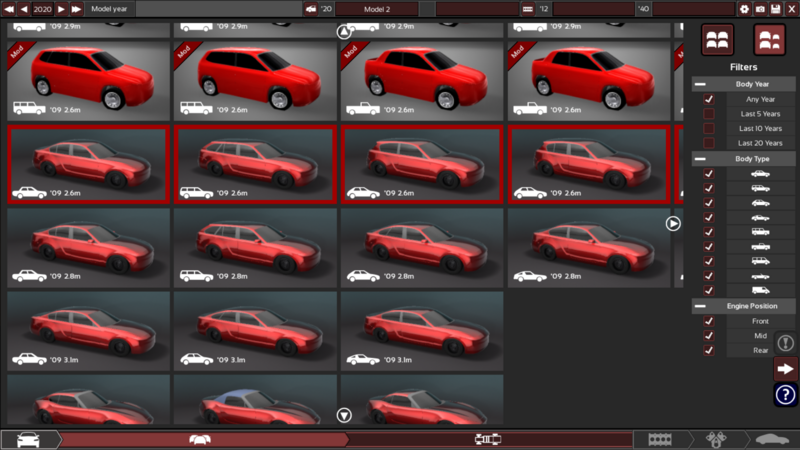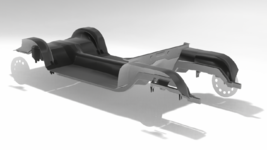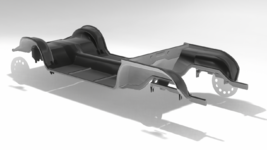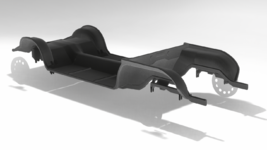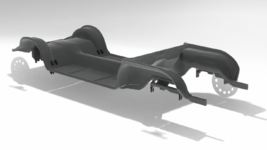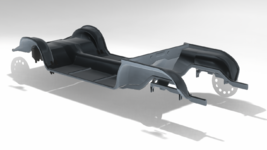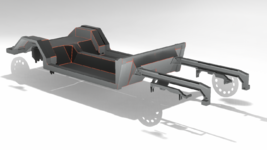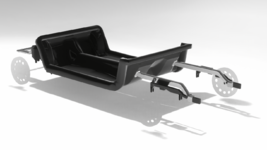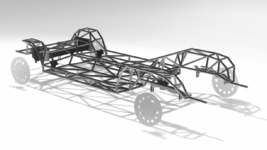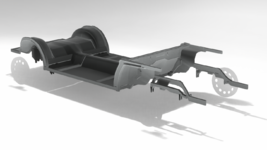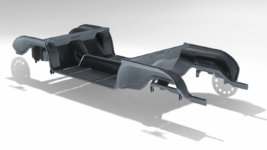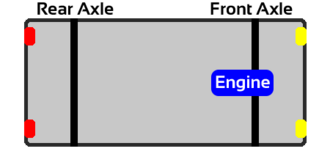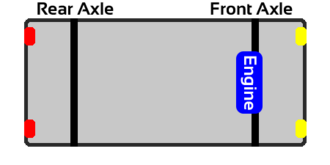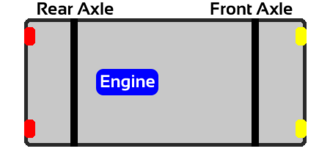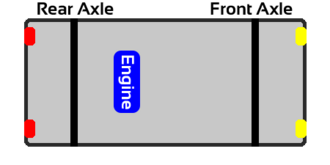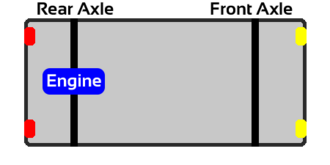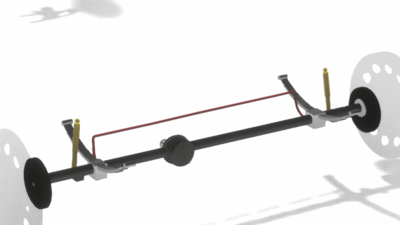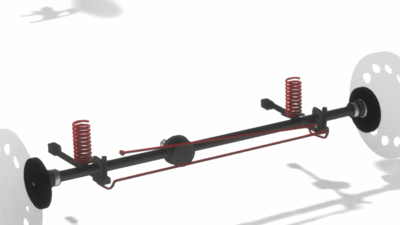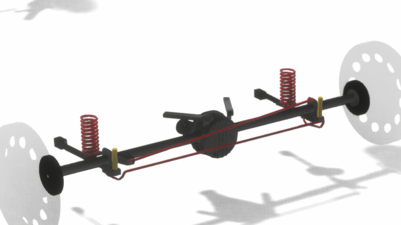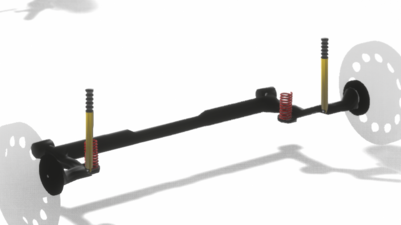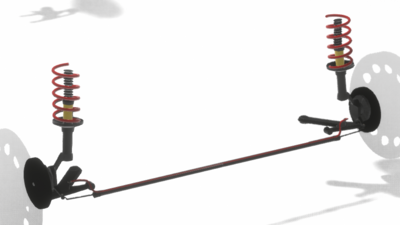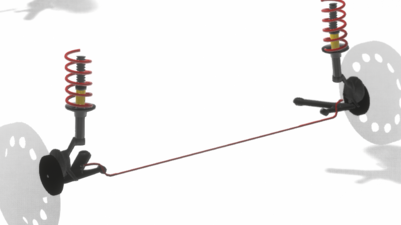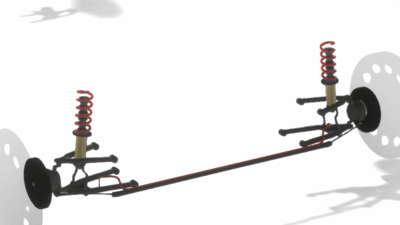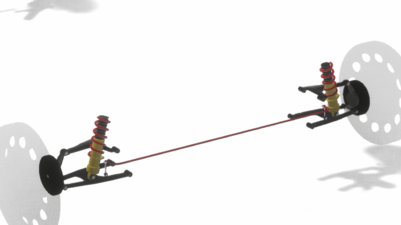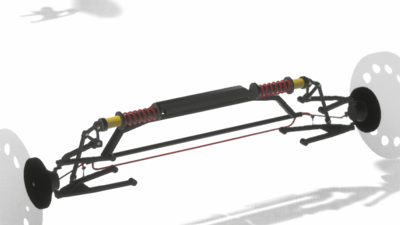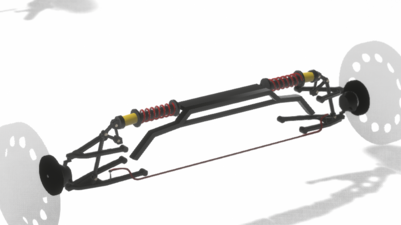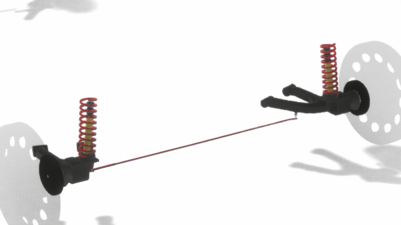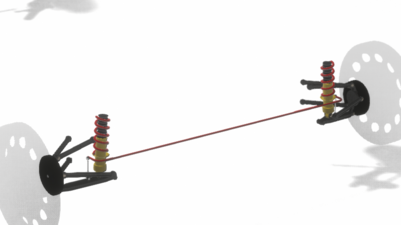Introduction
When creating a new car model, the first part of the car to design is the platform upon which the car model will sit. A car's platform includes its chassis and suspension geometry. The decisions made in the chassis design area will decide the purpose of your vehicle.
Creating a new model
Upon the creation of a new model, you will be placed in this page. This section of the car designer is the model designer. This is where you will build the backbone of your car(s).
On the upper left corner, you can set any model year you desire from 1946 through 2020. To the right of the year selector, you will find the name of your model (by default, a placeholder name of Model # is used), the name of your car trim, the engine family name, and engine variant name.
On the top right of the screen is a button representing game settings, photo studio, manual save, and exit options. Immediately below these buttons are options and filters that change how the car bodies are sorted and what variants will show up. Car bodies can be filtered out based on how old they are, what body type(s) they are, and available engine positions. The game currently has 553 unique bodies and variants, and more are available through the Steam Workshop as mods.
All mod bodies and fixtures contain a "Mod" banner on the upper left corner of their thumbnails.
Hovering your mouse cursor over the car bodies will reveal details about them, such as their wheelbase length, drag coefficient, front and rear lift, available engine positions, and the file name of each car body. Car bodies exist as families, some families only having one body style variant, while others (such as the highlighted 2009 2.6m bodies) exist in multiple body styles. This means you can built a large variety of cars on top of the same chassis. In the real world, this is commonly done in order to cut down on costs.
Once you have selected a body family, you can now proceed to the chassis design page.
Designing a chassis
When designing a chassis, you are decided how your car will be built. This includes the materials and architecture of the chassis, and the geometry of the suspension. Your choices here will greatly affect what your car does, how much it will cost to build, and how it performs.
Panel materials
The car's body panels are like the outer skin of the car. They are what give the car its external shape, and include parts such as fenders, quarter panels, doors, rocker panels, hood, trunk and roof.
- Steel - Steel panels are built out of plain steel. Steel is the cheapest and easiest material to work with; however, steel presses are required to work with steel panels. Untreated steel has low environmental resistance due to its susceptibility to rust.
- Treated Steel - Steel that has been processed through chemical baths. Treated steel has improved environmental resistance compared to untreated steel, at the cost of greater expense, and the requirement of treatment baths to use this material.
- Corrosion Resistant Steel - Steel alloy that has been built and painted for rust resistance. Only requires steel presses to work with, but is more expensive than treated steel.
- Fibre Glass - Panels built out of woven glass fibres in an epoxy-based resin. These panels are lighter than steel and can be produced by hand. By hand, fibre glass cannot be mass produced. Using SMC (sheet moulding compound) injection, fibre glass can be used in limited production. Fibre glass's main downside is its fragility and cost. The material is not good for safety ratings, due to how it splinters in a crash.
- Aluminium - Panels built out of aluminium. Aluminium metal is lighter and naturally corrosion resistant compared to steel. The downside is that it is more expensive. Aluminium can be produced by hand, but cannot be mass produced without the correct equipment. Steel presses allow for limited production, and specialized aluminium presses allow for mass production.
- Partial Aluminium - Certain panels are built out of aluminium, and the rest are built from steel. The hood and trunk of the car is built of aluminium, while other more complex panels are built from steel. A compromise between full steel and full aluminium construction, this panel material can only be produced with steel presses.
- Carbon Fibre - Panels of woven carbon fibres in resin. Carbon fibre is the lightest and strongest of all materials. It is very expensive to use, and cannot be mass produced. It can be produced by hand, and carbon plants allow for limited production.
Chassis types
The car's chassis type describes how its body is constructed. These methods impact how heavy the car is, what its purpose will be, and what materials are available for use in the chassis. The chassis type will affect available choices for engine placement and suspension geometry.
Ladder
A ladder chassis, otherwise known as a body-on-frame chassis, dates back to the old days of horse-drawn carriages. The car's body and frame are two separate objects. The frame itself is built from thick steel rails, joined together with three metal ribs in the center. The body is mounted on top of the frame.
This construction method has many advantages. For one, it is the cheapest and simplest construction method. Secondly, this method gives the car great offroad capability, as the rugged frame protects the body from the ground. Third, this sort of body construction is easy to repair in case of damage. Finally, this construction method has good load bearing characteristics.
The drawbacks of body-on-frame construction are poor safety. This is because in a crash, the frame acts as large metal spears, potentially causing injuries and more damage. The other major drawback is weight. Because the frames have to be built of heavy-duty steel, they are quite heavy as a result. Nowadays, ladder chassis are only used for offroad and utility vehicles. Available chassis materials for body-on-frame chassis include steel, galvanized steel, corrosion resistant steel, and advanced high-strength (AHS) steel.
Monocoque
A monocoque chassis, otherwise known as a unibody chassis, is the modern-day standard for passenger car frames. The name monocoque is French for 'single-shell', which properly describes how a unibody is built. Rather than using a separate body and frame, a unibody chassis integrates the frame and the body's structure together.
The advantages in this construction method include lighter weight, superior safety, and improved torsional rigidity. A more rigid body is important, especially in a performance car, as body flexing may cause rollovers, loss of controls, and misaligned suspension. Another advantage of the monocoque chassis is the diverse selection of materials that can be used to build it.
Unibodies can be built with steel, galvanized steel, corrosion resistant steel, AHS steel, light AHS steel, glued aluminium, or carbon fibre. The carbon fibre monocoque is unique in that it uses aluminium subframes and does not have built-in wheel wells.
Space Frame
Like the ladder chassis, a space frame chassis, otherwise known as a tubular chassis, utilizes a body mounted on a separate frame. However, unlike the ladder chassis, the frame design used here is different. Instead of using thick steel beams in a ladder shape, this frame uses multiple steel tubes interconnected in triangular trusses.
The advantage of this construction method means that it can be built by hand, and, compared to a ladder chassis, is much lighter weight and torsionally rigid. The disadvantage of a space frame compared to a ladder frame is the inability to mass produce a space frame design.
Historically, space frames have been used specifically in classic low-volume sports cars. Nowadays, space frames are no longer used by major car manufacturers; however, the producers of kit cars and certain specialized low volume car brands continue using the space frame design due to its aforementioned advantages. Outside of cars, the space frame design is used in older small aircraft frames and used in architecture.
Available materials for space frames includes steel, galvanized steel, corrosion resistant steel, and AHS steel.
Semi-Space Frame
The semi-space frame chassis exists as a combination of construction methods found in monocoque and space frame chassises. The central core of the chassis is built solid like a unibody, however, the outer ends of the body are built using subframes built like a space frame.
This construction technique is lighter than a standard monocoque chassis, while retaining the desirable traits of a monocoque, such as its safety. The disadvantage is that it is more expensive to engineer, and the aluminium material it uses is more expensive than any steel options.
This construction method had been pioneered by German automaker Audi, in the mid 1990's, in their A8 luxury sedan.
The semi-space frame chassis can only be built using aluminium.
Light Truck Monocoque
The light truck monocoque chassis is another combination of two previously mentioned construction techniques. This time, its the monocoque and ladder chassis that are combined together in one. As the name suggests, this construction method is mainly found in light trucks. The cabin portion of the truck, where the passengers sit, is built in the fashion of a monocoque body, however, the area underneath the bed of the truck is built using a ladder subframe. This allows the chassis to be simpler and cheaper than a full monocoque, while perserving some advantages of the monocoque chassis such as improved safety and lighter weight.
Available materials for the light truck monocoque include steel, galvanized steel, corrosion resistant steel, AHS steel, and light AHS steel.
ㅤㅤ
Chassis materials
There are a multitude of materials that can be used to build a chassis. The availability of certain chassis materials depends on the design of the chassis itself. Almost all materials used for chassis construction are either pure metals, or alloys, with the exception of carbon fibre. Alloys are a type of metal made from the mixing of two elements, at least one metal.
- Steel - Standard steel alloy, made from iron and carbon. Its main advantage is being cheap and abundant. Steel has the poorest environmental resistance due to its susceptibility to corrosion. All chassis types except semi-space frame can be built using steel.
- Galvanized Steel - Steel alloy that has undergone the galvanization process. Galvanization builds up corrosion resistance by electroplating a zinc anode to the steel. The zinc acts as a shield against corrosion, protecting the more structurally important steel from rusting. The zinc itself eventually corrodes. All chassis types except semi-space frame can be built using galvanized steel.
- Corrosion Resistant Steel - Steel alloy that has been rust-proofed by a coating. The chassis itself is also built using tighter tolerances and tougher seals, to prevent water from getting in where it shouldn't be. Due to these extra anti-rust measures, corrosion resistant steel chassises are harder and more expensive to build. All chassis types except semi-space frame can be built using corrosion resistant steel.
- AHS (Advanced High Strength) Steel - a specialized steel alloy designed to be stronger than standard steel. This means lighter weight, higher tensile strength, and superior environmental resistance. The downside of AHS steel is its higher expense compared to standard steel alloys. All chassis types except semi-space frame can be built using AHS steel.
- Light AHS Steel - Due to the higher tensile strength of AHS steel, a chassis can be built using less steel. This makes the chassis even lighter, at the expense of engineering time and safety. Only monocoque and light truck monocoques can use light AHS steel.
- Glued Aluminium - Aluminium panels are used in the place of stamped steel. Aluminium is lighter and more corrosion resistant than steel. The aluminium panels are glued using high strength aerospace grade adhesive. Aluminium chassises are more expensive and difficult to engineer and produce compared to their steel counterparts. Only monocoques and semi-space frame chassises can use glued aluminium.
- Carbon fibre - A carbon fibre tub is used as the core of the chassis. This rigid carbon fibre tub is highly resistant to body flexing, and is very lightweight, two highly desirable traits for sports and super cars. However, carbon fibre is a very expensive material. Only monocoques can use carbon fibre.
Engine placement
The engine placement refers to where in the car the engine is positioned. Engine placement can be affected by chosen chassis design. Engine placement will affect the amount of space available in the engine bay, available suspensions types, and available drivetrain types. The vast majority of cars are built using a front engined layout. Not all car bodies in Automation have access to all engine placements.
- Longitudinal Front Engine - Engine is mounted right behind or above the front axle, parallel to the car's direction of travel. This engine layout can accommodate FWD, RWD, AWD or 4x4.
- Transverse Front Engine - Engine is mounted above the front axle, perpendicular to the car's direction of travel. This engine layout can accommodate FWD or AWD
- Longitudinal Mid Engine - Engine is mounted between the passenger compartment and rear axle, parallel to the car's direction of travel. This engine layout can accommodate RWD or AWD.
- Transverse Mid Engine - Engine is mounted between the passenger compartment and rear axle, perpendicular to the car's direction of travel. This engine layout can accommodate RWD or AWD.
- Longitudinal Rear Engine - Engine is mounted right in front of or above the rear axle, parallel to the car's direction of travel. This engine layout can accommodate RWD or AWD.
Suspension geometry
In Automation, eight different suspension geometries are available for use in your car. These cover the most popular suspension designs for a diverse array of cars. In general, there are three categories of suspension design: dependent, semi-independent, and independent. These types of suspensions are group based off of common behaviors they may exhibit.
Dependent Suspension
Dependent suspension is a type of suspension geometry where if one wheel experiences a change in camber due to a bump or pothole on the surface, the other wheel will experience the same change in camber, but in the opposite direction. These types of suspensions are the simplest design, as they are essentially one solid transverse beam connecting two wheels.
- Solid Axle Leaf - The most basic suspension option in Automation. This suspension design uses a rigid connection between the two wheels, and two sets of leaf springs. Leaf springs are stacked sheets of metal that flex in response to the load they carry. Solid axles with leaf springs are excellent for transporting heavy loads, due to the solid axle's ability to maintain perfectly constant camber. Essentially, the wheels will always be perfectly perpendicular to the axle. This axle type can be mounted in the front or rear of a front-engine vehicle, but can only be mounted in the front of a mid- or rear-engine vehicle. Due to the characteristics of this suspension type, it is commonly used as the rear suspension of light utility vehicles, and as the front and rear suspension of heavy utility vehicles.
- Solid Axle Coil - A more advanced solid axle design, using coil springs in the place of leaf springs. Coil springs offer superior driving dynamics, comfort, and offroad capability compared to the leaf spring, while still being able to carry heavy loads. This axle design was popular with all kinds of RWD cars from the post war era to the 1990s, even persevering until 2014 in the Ford S197 Mustang. This axle type can be mounted in the front or rear of a front-engine vehicle, but can only be mounted in the front of a mid- or rear-engine vehicle. Due to the characteristics of this suspension type, it is commonly used as the rear suspension of light utility/offroad vehicles, and the front and rear suspension of dedicated offroad vehicles.
Semi-Independent Suspension
Semi-independent suspensions work similarly to a dependent suspension, where the action of one wheel affects the other, but unlike dependent suspensions, the action of one wheel isn't fully mirrored by the other wheel. This is because the linking between the two wheels is flexible rather than rigid.
- Torsion Beam - The most basic non-solid axle type suspension in game. This suspension design uses a flexible connection between the two wheels, and coil springs. The flexible connection twists itself in reaction to one of the wheels experiencing camber change, hence the name. The twisting of the beam causes a slight change in camber for the opposite wheel, but this camber change doesn't mirror the incident wheel. This suspension type is commonly use in economical FWD passenger cars. This suspension type can only be mounted in the rear of a transverse front engine car, and cannot be powered, meaning AWD is unavailable for vehicles with this rear suspension.
Independent Suspension
Independent suspension works by having each wheel act as two independent system. If one wheel undergoes camber change, the other wheel remains unaffected. While independent suspension designs are the most complicated, they offer the best in comfort and performance through superior handling dynamics thanks to their more precise camber control.
- MacPherson Strut - One of the most basic independent suspensions, the MacPherson strut is composed of a lower control arm, a coil spring, and a shock absorber. The MacPherson strut's forte is its simple and efficient packaging; all components of the suspension are vertically stacked on top of each other, granting additional space for an engine to be mounted in between. MacPherson struts are commonly used as the front suspension of basic FWD vehicles, as the suspension type pairs well with a wide transverse engine layout. The MacPherson strut's disadvantages are less precise camber control compared to other independent suspension designs, leading to less sporty handling characteristics. This is because when the suspension is being compressed, the wheels can only gain up to a certain amount of negative cambering. The suspension system is also less comfortable due to both the wheels and shocks going through the same vertical motions. MacPherson struts can only be installed in the front of a front-engine car, but can be installed in the front and rear of a mid- or rear-engine car.
- Double Wishbone - Double wishbone suspension is one of the most versatile independent suspension setups, having a good balance of comfort, handling, cost and packaging. Double wishbone suspension, less commonly known as double A-arm suspension, is equipped with two control arms per wheel, along with a coil spring and damper assembly. Double wishbone suspension provides superior camber control, as they increase the wheel's negative cambering with under compression, allowing for grip to be maintained on rougher terrain. Double wishbone suspension also provides superior load bearing characteristics compared to strut suspension. Double wishbones are commonly used in all sorts of sporty, premium and luxury cars of all drive types, in both front and rear suspensions, and used as the front suspension of light utility vehicles. This comes at a cost of increased complexity and weight. In the game, double wishbones can be mounted in the front or the rear of the car, on any type of drive layouts. In that regards, double wishbones is the most versatile suspension type.
- Pushrod - Pushrod suspension is the most complex suspension type in the game. Pushrod suspension is a dedicated performance suspension type, being used in various supercars and hypercars, as well as race cars. Pullrod suspension also exists in many race cars, but is not available in Automation. The pushrod suspension's geometry is based off the double wishbone suspension's geometry, employing the use of twin control arms like a double wishbone suspension. The major difference between a pushrod suspension and a double wishbone suspension is that the pushrod suspension is designed to take up as little vertical space as possible, and, as a result of its design, has a far lower center of gravity, and is effective in limiting body roll due to its ability to transfer forces transversely through the horizontally mounted coil springs and dampers. The downsides of pushrod suspension includes costs, complexity, and the inability to lift a car's ride height very far with this suspension setup (although that disadvantage can be ignored, as the cars that use this suspension setup benefit a lot more from low ride heights). Pushrod suspensions also take up a lot more space than any other suspension setup, due to the use of transverse coils and dampers. As a result, pushrod suspension can only be mounted on the rear axle of a front engine car, or the front axle of a rear engine car. However, this suspension setup can be mounted on both front and rear of a mid engine car.
- Semi Trailing Arm - Semi trailing arm is a type of independent rear suspension. This suspension design uses one large triangular control arm, a coil spring and a damper. The wheels of the axle are solidly mounted to their respective control arms. This setup is one of the simplest independent suspension setups. Its advantages are compactness and simplicity, however, this comes at a cost of weight, comfort and handling. Due to the wheels being solidly mounted to the control arms, more vibrations are transferred from the road to the car's body. The suspension is unable to maintain constant toe angle, meaning that during suspension travel, the wheels may experience a little bit of change in toe angle. Toe angle refers to the angle of the wheel in relation to the car's horizontal axis. A wheel of 0 toe angle is parallel to the car's body and direction of travel. Semi trailing arms are commonly used in economical cars. In the game, semi trailing arms can only be mounted in the rear suspension of a front engine car. The main appeal of a semi trailing arm is its superior handling compared to a torsion beam, and compatibility with RWD and AWD, while remaining relatively simple.
- Multi-Link - The multi-link suspension is one of the most complex independent suspension systems. This suspension design incorporates great handling and the best comfort in game, at the cost of being the second most complex suspension system. Multi-link suspensions can use three or more lateral arms and one or more longitudinal arms. The in game design uses three lateral arms, and two longitudinal arms. These five arms allow the multi-link suspension to display good behavior, such as good camber control in situations that require good handling. One less expected advantage of the multi-link suspension is in offroad use. The multi-link suspension is able to flex more than other suspension designs, allowing it to negotiate rough terrain. The five link multi-link systems is preferred, as they allow for the wheel to move vertically, without rotating in/out or sliding forwards/backwards. The arms of the multi-link suspension have spherical joints or rubber bushings on each end, allowing them to use tension and compression to work without bending. A multi-link suspension system can be straight forward to tune, as the modification of one arm can only affect on attribute of the suspension system. The disadvantages of multi-link suspensions include complexity, cost, difficulty in engineering, and reduced load bearing. Multi-link suspensions are commonly associated with performance and luxury cars, however, this suspension design has been "trickling down" to cheaper cars, such as the new Toyota Corolla. In the game, multi-link suspension can only be mounted in the rear suspension of a front engine vehicle.
Completion
Now that your model is completely built, you can either design an engine for your car, or equip an existing engine and begin work on the trim(s) of the model. Remember - the car model designer is only a baseline for your car, and the finished product is designed through the trim designer.
